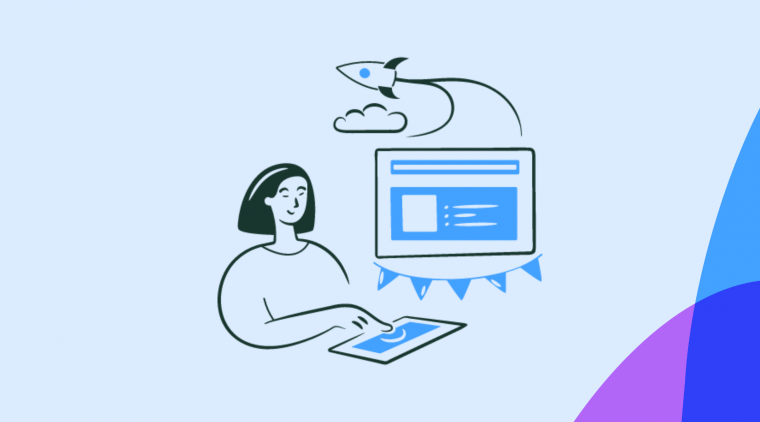A fake door test is a method used by product and UX research teams to understand if a new product, feature, or benefit is attractive to users. It teases the opportunity to trial the new product, feature, or benefit with a click; but doesn’t actually deliver. This method gives product teams great insight into their product-market fit, but can cause some disgruntled users.
Fake door testing is a dangerous game. Done right, you can win future customers, validate an idea for a product launch, and even find beta testers for a new feature. Done wrong, you could damage your brand reputation and risk a PR nightmare.
So, where’s the middle ground? How can you run fake door tests that help product-led business growth while building trust and buy-in from your customers?
Come on in; we’ll show you how.
Fake door tests present an invitation for a user to try a product or a feature that isn’t actually there. It represents what’s yet to come, and triggers curiosity, a fear of missing out, or excitement to try something new.
A fake door test can be shown as a CTA button, in-app notification, pop-up, slide-out, banner, or even a product video or an ad.
The benefits of using fake door tests include gathering relevant user feedback, minimizing the risk of failure, and evaluating even the smallest product updates before you go into development.
However, this research method comes with risks, too. Fake doors can cause potential distress, trigger disappointment, diminish credibility, or break trust in your brand.
How to avoid risks? Be honest and transparent in your messaging. Make sure to convey a clear message that will instantly reveal what the test is all about.
To make an effective fake door test, choose the right tools, pick your audience, build a test and a follow-up journey, gather data, and measure success.
Translate quantitative and qualitative feedback into actionable insights that will help you build better products and increase user adoption.
What is fake door testing?
Fake door testing is a lean research technique product teams use to validate new products, features, or services. Sometimes called painted-door tests, they present users with an invitation to use a product that isn’t actually there.
Typically, a fake door test will be a CTA button, in-app notification, or pop-up taking users to a low-fidelity prototype of a product idea or anything that mimics the visual aspect of an existing product.
When the user clicks or signs up for that fake product, they receive a message or land on a page that comes out with the truth the product doesn’t exist (yet).
Fake door tests are excellent for:
Finding a product-market fit
Lowering the adoption risks of new ideas
Encouraging users to to stick around by ensuring them what's to come
Using data like clickthrough rate and page interactions for decision making
Triggering curiosity or fear of missing out (FOMO), exciting users to try something new
Helping you find new customers, build personas, and define demographics (with fake door targeted ads)
Fake door testing also comes in many shapes and sizes, such as:
Pre-order forms: measure genuine interest and demand by allowing users to input their information and order a product before its released
Interactive prototypes: Resembling the real product, interactive prototypes can test your user’s reactions to new website features, software interfaces, and website layouts
Landing page simulations: Fully pitch the product as if it was available with copy, descriptions, images, and CTA buttons
“Coming soon” teasers: Similar to landing pages, teasers are used to gauge interest, generate buzz around your brand, heighten and pique curiosity
Feature preference surveys: Users can answer feature preference surveys after they interact with a fake door, helping you understand which product features you need to develop
When done right, fake door testing can help you find your product-market fit and lower adoption risks of new ideas. Do it wrong, and you could break customer-brand trust.
Let’s look at the benefits of setting fake door tests for your potential customers to try and open up.
How do fake door tests benefit the design process?
Despite the general fear around fake doors, there are some great benefits for businesses. Let’s explore what some of these fake doors can do for your team.
Gather feedback on how users respond to a new offering
First and foremost, gathering feedback with low investment is a fantastic way to minimize product build risk and save on engineering resources.
Depending on the tools you use and the fake door test you choose to run, you have the opportunity to collect both qualitative and quantitative feedback that can radically improve the build and pitch of a new idea—and support a product launch.
Evaluate even the smallest in-product new features
You can also use fake door tests to understand how current users feel about a new feature.
Whether your fake door test comes within an interactive product tour for new users, or you present it as a modal pop-up for existing users, you can gauge initial interest in the minutest of features and get people excited for what’s to come.
How does this work? Take a look at a hypothetical test that Curtis Stanier, Product Lead at Delivery Hero, created to showcase the example he lays out in his Medium article on painted-door testing.
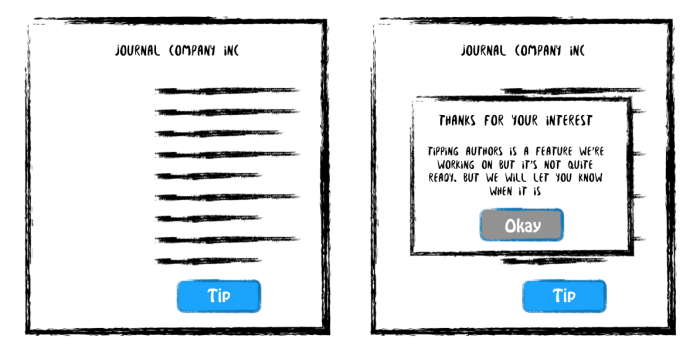
(Source)
Develop features your users want and disregard the ones they don’t
Fake door tests are a fantastic tool for validating new features and winning initial buy-in from existing users. Of course, for this user research tool to work, you need great user engagement in your platform, and people need to be accustomed to providing user feedback.
Fake doors are also great for disregarding new features you’re considering. For example, if you’re using an MVP approach to your product, you may receive customer feedback that states the importance of a feature for a particular customer.
However, when you run a fake door test to measure the popularity of this feature idea, it could reveal that the lift is not worth the investment.
Lastly, fake door tests are a great way to prioritize your product backlog. If you’re unsure of what to work on first, ask your customers via fake door tests and let them answer.
Run a fake door test to gauge feature interest
Discover the 6 easy steps to run a fake door test with Chameleon and some of your favorite tools, and learn what your users really want you to build.
Segment users for beta testing and feature up-selling
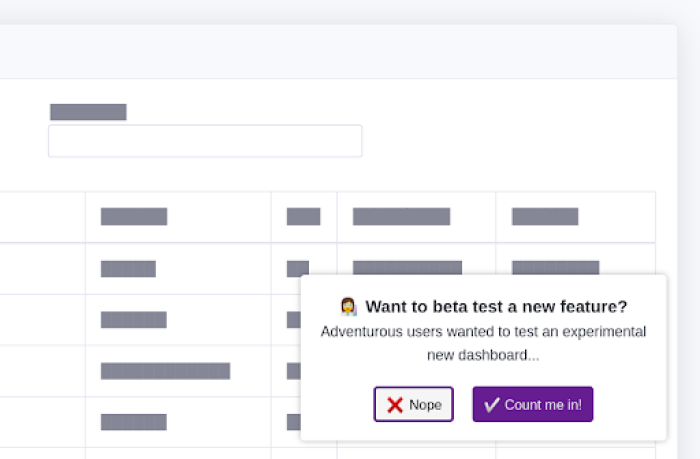
Fake door tests can be the perfect tool to help you segment your user base for beta testing.
For example, perhaps you’re building a feature that a certain user really wants. Rather than offering the feature to all users, offer it to those that care about seeing it succeed.
Offering beta testing opportunities is a great way to build user engagement and gather qualitative user feedback. This also ups your feature adoption rates when you do bring it to market.
Once your beta testing is over and you’re ready to release your new feature MVP, you already have an invested group of (ex-beta) users that could be willing to pay for this—just make sure you offer it at an exclusive rate. Say thanks.
Discover new customer cohorts with a fake door test
Fake door tests can also be beneficial if run out of product and via targeted ads. They can help you find product-market fit early on and identify entirely new groups of customers for a product launch.
For example, if you have an idea about your target audience, you can run social media ads or Google PPC campaigns that entice someone to a landing page and low-fi design of the product, feature, or service to come. In doing so, you can start building lookalike audiences for future advertising.
Plus, if you’re collecting emails in your fake door tests, then you can build a list of people that want to know more and will potentially convert to a sale when your idea is ready.
Well, we’ve covered the benefits. However, that’s not to say fake doors come without risks.

Chameleon is your one-stop-shop for onboarding and fake door testing
Run fake door testing and get real results with Chameleon at the head of your product-led growth stack.
How to make an effective fake door test in 5 streamlined steps
Right, now that you know the benefits of fake door testing, let’s get into how to make fake doors.
1. Pick your audience
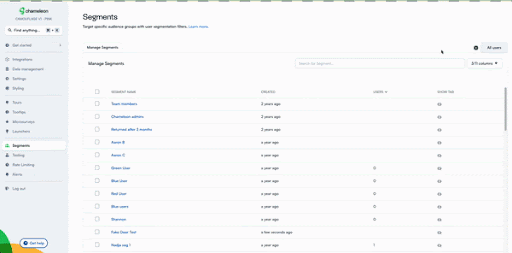
First and foremost, who are you creating this test for?
Will you be looking to get early adopters? Will you be targeting potential customers via advertising? It’s a great option if you want to test a new business model or product. Or, will you be targeting users that are already navigating your product? This is a good option for new features and if you have an engaged user base.
Once you decide who the test is for, you can build with greater awareness.
2. Create the fake door

Next, you’re ready to build your fake door. The fake door itself needs to be equal parts enticing as it is informative. Breadcrumb your users with just enough information to win a relevant click-through.
For example, that’s exactly what Buffer did for their new Start Page feature. By placing a CTA in the notification bar on their website Home page, they encourage visitors to sign up for early access. When someone clicks on the CTA, they land on a page where they can leave their email address to join a waitlist.
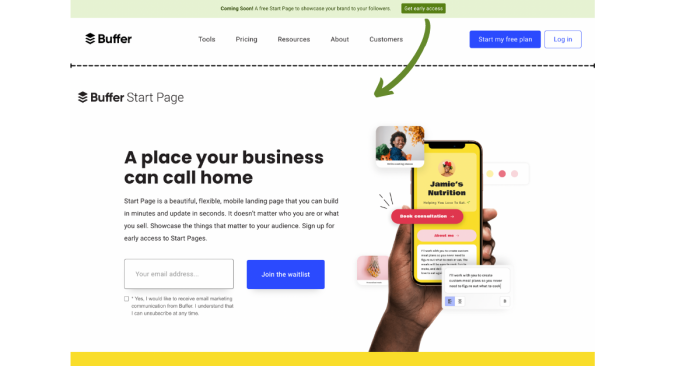
3. Create what's behind the fake door
Now it's time to create what lurks behind the fake door. Remember to keep things simple, and transparent once someone is inside.
This is where a great empathetic copy can go a long way. So spend time with your copywriter to ensure the wording is just right and you remain serving a delightful experience for users.
Things to include in your test content:
The purpose of the new product
The key benefits of the new product
A potential roadmap
How the user can help
An option to sign-up for more
Visual aids: screenshots, wireframes, or a product video
Here's a real-life example. Let’s take a look at how Dropbox did it back in 2019 when they announced the new desktop app. On the announcement page, they included the opt-in option for the existing users, to get early access and take the new app for a spin. Plus, they added a dedicated button for collecting feedback.
“Ready to try out the new Dropbox experience for yourself? All Dropbox users can opt in to the new desktop app through our early access program, and we’re rolling out the other features over the next few weeks. We can’t wait to hear how you’re using the new Dropbox, what you like, and what you want more of—look for the “Send feedback” button in the lower-right corner of the new desktop app.”
All that was accompanied by an engaging new Dropbox announcement video.
4. Work on your follow-up journey
Remain accountable for whatever you promise your page visitors.
If you promise more information as you build, then deliver that.
If you promise the option to be a beta tester, then invite them.
If you say that the product should be ready by a certain date, then get that MVP in their hands or let them know why it’s not ready.
Communication is critical for maintaining the relationship you’re building with the fake door test.
You may also have some stellar product-qualified leads for future marketing, so make sure you’ve got an email campaign in place for when the product is available.
5. Gather data and measure success
It’s important to set some KPIs around what would be the success of your fake door test.
Are you looking for a certain click-through rate to give your team the green light and start the build? Perhaps you need a certain number of positive feedback responses to let your PM team know an idea is valid.
A few goals and data sets to measure are:
Conversion rate
Click-through rate
Email signups
Bounce rates
Positive user feedback
Negative user feedback
The quantitative data and qualitative responses you receive from your fake doors will be crucial to informing your new product or feature build.
Whether this is an in-product test or something you’re running externally, make a decision on whether it’s worth it as a validation method. If the negative feedback outweighs the positive, you’ll need to either reassess your fake door test or consider scrapping it from your lean development process altogether.
Tools to make fake door tests with
There are plenty of product marketing tools to help you get the job done; a few fan favorites are:
Wondering whether to try Userpilot or Chameleon?
Unsure whether Chameleon or Userpilot is the best tool to help build in-app fake door tests? Compare the two tools right here.
Now you’ve got your tools, let's take a closer look at some fake door test examples to set your product ideas in motion.
5 Fake door test examples to inspire great products
The best way to create effective fake door tests is to learn it from the pros. Let’s take a look at some of the companies that have masterfully implemented this method for finding a market fit.
Dropbox: before the product was ever fully developed, Dropbox made a landing page with a video that effectively persuaded people to sign up and then directed them to a wait list. This fake door test effectively gauged people’s interest (and patience) for their cloud storage service.
Groupon: masterfully created a fake door test through a WordPress blog, showcasing deals and offers with no actual products available. Their goal? Test the market for high-demand before they even started building the platform.
Zappos: had a specific question to figure out—will people buy shoes online? The founder created an eCommerce website and used pictures of shoes from real stores. When people started ordering, they’d be taken to a “sorry, out of stock” page. Since it was under a different name, Zappos suffered no brand reputation damage. Zappos proved that selling shoes online would be viable.
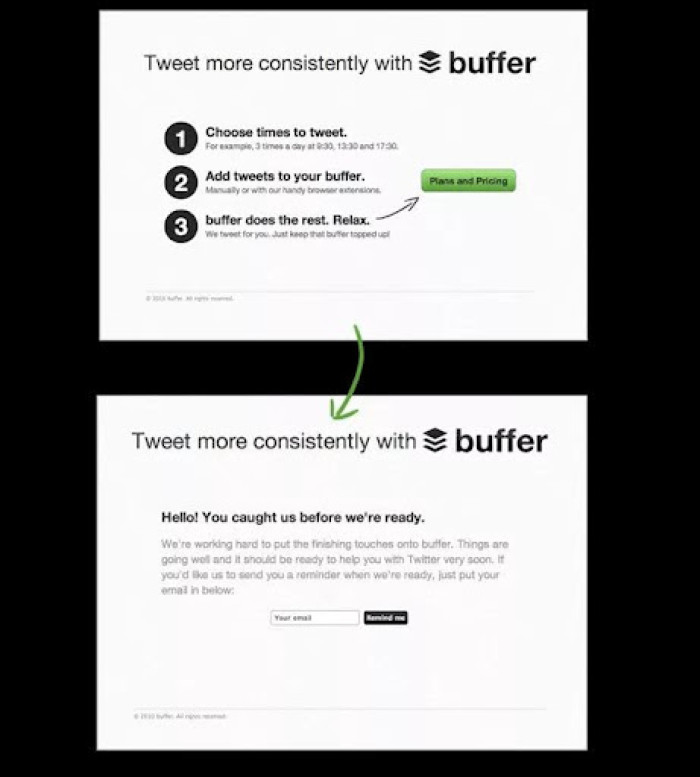
Buffer: With a landing page and a button prompting users to “try Buffer”, the social media scheduling tool led to a waiting list. By encouraging users to leave their emails, Buffer was able to both validate their idea and build their user list.
The kickstarter method: This is more of a model used by multiple companies. It works by asking potential customers to pre-order a product. Doing so allows you to check for a guaranteed market and de-risk expenditure.
Those are some fake door testing success stories. However, guaranteed markets and idea validations aren’t the only outcomes. Fake door testing isn’t the safest testing method— so it’s best you know the risks that come with it.
Risks of fake door testing and how to avoid them
For all of the benefits available to a business running a fake door test, there are risks to running them as well. But these risks can be avoided, or at the least, minimized.
Fake doors can cause potential distress
It takes time to build relationships with customers. A fake door test is essentially an upfront fib about what the customer is about to get. This causes distress and potentially diminishes a customer’s trust in a business.
However, there are ways for you to remedy the fib immediately. On the click-through landing page, be transparent and honest with your copy. Let the visitor know that you’re considering working on this feature and thank them for their time.
As soon as you validate a customer’s feelings, you can remedy the relationship and even get them excited about what’s to come. But, you need to act fast with your copy.
Fake door tests can trigger disappointment
Of course, there’s a certain amount of disappointment someone will experience if the solution they thought they were getting is not available to them. It's essentially a fake advertisement.
You can avoid this by empathetically handling the user’s disappointment. Explain the reason behind your actions, and ask users if they would like to leave feedback on their expectations with a product survey or participate in a beta version of the product for free.
Integrate user feedback tools wisely, and be cautious of asking too much from someone.
Lastly, build a sense of community around your new product and let your users know how heavily they can positively influence what’s to come. Assure them you’re essentially building something to answer their needs. Remain customer-centric.
Fake doors might diminish credibility
If you’re a relatively new SaaS or are targeting a new audience for your fake door test, then credibility is a big thing. Ever heard the expression: starting off on the wrong foot? The same applies to your fake door.
How do you remain credible with fake door testing? There are a few ways.
One is with the messaging on your landing page and the things we’ve mentioned above: beta testing, feedback opportunities, and sharing insights on what’s to come.
Two, if you choose to target a new audience, keep your testing cohort and spend small. You may damage a few relationships with potential users. However, if you gain valuable insights, then you’re more likely to present a better-fitting product to the masses.
Risks covered. But what happens once you get your fake door test up and running?
You've created a fake door test. What's next?
Fantastic, so your fake door test is up and running, and you're ready to drive traffic and gauge interest. It’s time to zoom out and look at the bigger picture. It can be overwhelming getting this test right. Remember why you ran this test in the first place.
Your fake door test is a crucial part of your product development process. It helps your researchers to gather data and developers to test, iterate, pivot, and evaluate new ideas.
Document your learnings from the fake door test and share it with your team. Who needs to know what? And why? How can you translate quantitative and qualitative data into actionable insights that will help you build better products and increase user adoption?
Closing the door on fake door testing
That’s a wrap on fake door testing. Despite the stigma, fake door tests work, and if done right, they can be extremely beneficial to your business and your customers.
Remember, once a user is ‘through the door,’ they’ve already provided you with valuable insight on your hypothesis. Make sure you provide value back and continue the conversation around the topic.
Thanks for your visit—we hope to see you again soon!
Create fake door tests, no engineering needed
With Chameleon, you can launch experiments fast and iterate quickly
FAQS for fake door testing
-
1. How many fake doors should you build for your test?
-
The number of fake doors for your test will depend on the scope of your hypothesis and your audience testing size. Try having one fake door for each hypothesis you want to test. If you have a large and diverse audience, you’ll need a higher number of fake doors to test out different segments.
-
2. What are the risks of fake door testing?
-
The three main risks of fake door testing include: Fake door tests can cause customer distress Fake door tests can trigger disappointment Fake door can diminish your brand’s credibility
-
3. Why should you conduct a fake door test?
-
You should conduct fake door tests because it helps you validate market demand for your product, gather user feedback, and ultimately minimize its risk of failure when you finally do launch your product or feature update.



